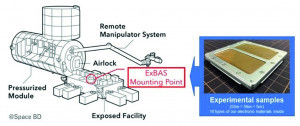Panasonic is planning exposure experiments in space with the aim of developing state-of-the-art electronic materials for aerospace applications. The aim is to provide high-quality materials that function reliably in the harsh environment of space.
 Fig. 1: ISS with the Exposed Facility for material acquisition In recent years, the aerospace industry has accelerated the development of space technologies with a view to solving environmental and social problems on Earth. This includes projects such as the comprehensive promotion of manned activities on the lunar surface and the improvement of services with low-earth-orbit satellites.
Fig. 1: ISS with the Exposed Facility for material acquisition In recent years, the aerospace industry has accelerated the development of space technologies with a view to solving environmental and social problems on Earth. This includes projects such as the comprehensive promotion of manned activities on the lunar surface and the improvement of services with low-earth-orbit satellites.
The Japanese electronics group Panasonic Industry Co. Ltd. announced at the end of June 2022 that it is participating in the Space Delivery Project - RETURN to EARTH - which is sponsored by Space BD Inc. Research objects collected by domestic and foreign research and educational institutions and private companies will be transported into space to conduct space exposure experiments.
The companies' experimental samples are installed on the Exposed Experiment Bracket Attached on i-SEEP (ExBAS), which is mounted on the IVA-interchangeable Small Exposed Experiment Platform (i-SEEP) of the Japanese experiment module Kibo on board the International Space Station (ISS)(Fig. 1).
The Japanese Group is participating in the space experiments with materials for printed circuit boards and underfills at PCB level. The materials will be mounted on the Kibo experiment module during the 2022 financial year (until the end of March 2023) and will remain there for around six months. The samples will then be removed from the ISS and brought back to Earth on a cargo spacecraft. The material properties will be analyzed before and after use in space and the data obtained on changes will be used for future product development.
The products to be examined include
- Materials for multilayer printed circuit boards with low transmission loss of the MEGTRON series
- Materials for high-frequency printed circuit boards of the XPEDION series
- Materials for flexible printed circuit boards in the FELIOS series
- Highly heat-resistant materials for multilayer PCBs with low CTE from the HIPER V series
- Substrate materials for semiconductor packages in the LEXCM GX series
- Underfill for reinforcement at board level of the LEXCM series
The substrate materials for LEXCM GX series semiconductor packages are widely used in the field of communication infrastructure. The project enables experiments in space (an environment where microgravity, high vacuum, cosmic rays and wide temperature changes occur simultaneously) that are difficult to duplicate on Earth.
Panasonic has committed to the electronics materials project to support companies that want to test the commercial viability of the Moon and Mars and, if successful, may expand there in the future. It is also about technological innovations for high altitude platform stations (HAPSs).
Source:
https://news.panasonic.com/global/press/data/2022/06/en220622-2/en220622-2.html


